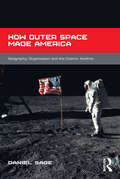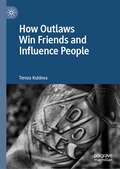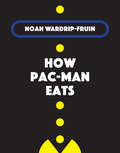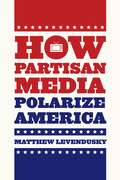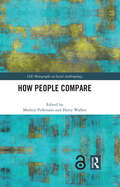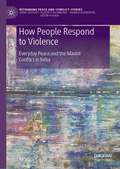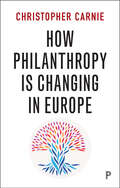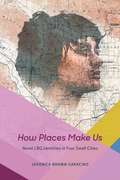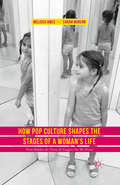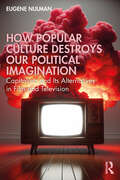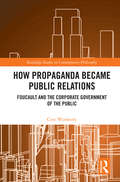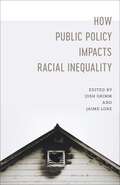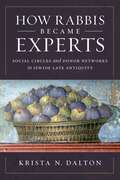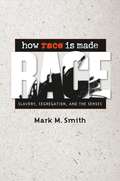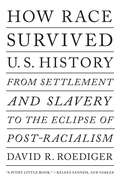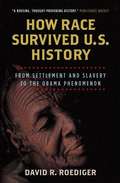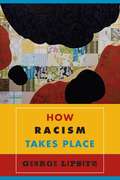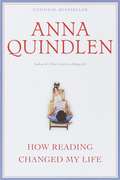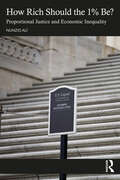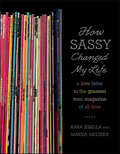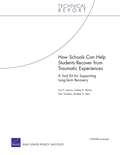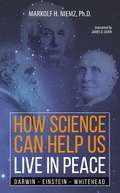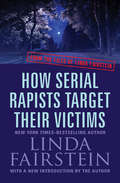- Table View
- List View
How Outer Space Made America: Geography, Organization and the Cosmic Sublime
by Daniel SageIn this innovatory book Daniel Sage analyses how and why American space exploration reproduced and transformed American cultural and political imaginations by appealing to, and to an extent organizing, the transcendence of spatial and temporal frontiers. In so doing, he traces the development of a seductive, and powerful, yet complex and unstable American geographical imagination: the ’transcendental state’. Historical and indeed contemporary space exploration is, despite some recent notable exceptions, worthy of more attention across the social sciences and humanities. While largely engaging with the historical development of space exploration, it shows how contemporary cultural and social, and indeed geographical, research themes, including national identity, critical geopolitics, gender, technocracy, trauma and memory, can be informed by the study of space exploration.
How Outlaws Win Friends and Influence People
by Tereza KuldovaThis book asks a critical question for our times: why do an increasing number of people support, admire and aspire to be outlaws? Outlaw motorcycle clubs have grown, spread and matured. Popular culture glamorizes them; law enforcement agencies fight them and the media vilify them. Meanwhile, the outlaw bikers exploit the current cultural and economic climate to attract new members. How Outlaws Win Friends and Influence People argues that the growth of these anti-establishment groups under neoliberalism is not coincidental, but inevitable. The book asks a critical question for our times: why do people today, in increasing numbers, support, admire and aspire to be outlaws? What needs and desires do the clubs satisfy? How do they win support and influence? Answering this is crucial if we are to successfully fight the social harms caused by these groups, as well as the harms that underlie their proliferation. Unless we understand the cultural dynamic at play here, our fight against these organizations will always take the form of a battle against the mythological Hydra: when one head is cut off, two more grow. “Tereza Kuldova is a rebel with a cause - her new book is a razor-sharp critique of stereotypical conceptions of the ‘outlaw biker’ and provides refreshing insights into their subjective life-worlds” - Daniel Briggs, author of the award-winning Dead-End Lives.
How Pac-Man Eats
by Noah Wardrip-FruinHow the tools and concepts for making games are connected to what games can and do mean; with examples ranging from Papers, Please to Dys4ia.In How Pac-Man Eats, Noah Wardrip-Fruin considers two questions: What are the fundamental ways that games work? And how can games be about something? Wardrip-Fruin argues that the two issues are related. Bridging formalist and culturally engaged approaches, he shows how the tools and concepts for making games are connected to what games can and do mean.
How Partisan Media Polarize America
by Matthew LevenduskyForty years ago, viewers who wanted to watch the news could only choose from among the major broadcast networks, all of which presented the same news without any particular point of view. Today we have a much broader array of choices, including cable channels offering a partisan take. With partisan programs gaining in popularity, some argue that they are polarizing American politics, while others counter that only a tiny portion of the population watches such programs and that their viewers tend to already hold similar beliefs. <P><P> In How Partisan Media Polarize America, Matthew Levendusky confirms--but also qualifies--both of these claims. Drawing on experiments and survey data, he shows that Americans who watch partisan programming do become more certain of their beliefs and less willing to weigh the merits of opposing views or to compromise. And while only a small segment of the American population watches partisan media programs, those who do tend to be more politically engaged, and their effects on national politics are therefore far-reaching. <P>< In a time when politics seem doomed to partisan discord, How Partisan Media Polarize America offers a much-needed clarification of the role partisan media might play.
How People Compare (LSE Monographs on Social Anthropology)
by Harry Walker Mathijs PelkmansThis book focuses on comparison in anthropology, turning an ethnographic lens onto the diversity of comparative practice. It seeks to understand how, why, and with what consequences, diversely situated groups of people – many of whom operate on radically different premises to professional anthropologists – make comparisons, above all between themselves and real or imagined others. What motivates people to compare, what techniques or logics do they employ, and what are the most likely outcomes - both intended and unintended? How do comparative practices reflect, reinforce or refuse uneven relations of power? And finally, what can a rejuvenated comparative anthropology learn from the anthropology of comparison? The volume develops a dialogue between scholars with long-term ethnographic engagement in a variety of contexts around the world and is particularly valuable reading for those interested in anthropological methodology and theory.
How People Respond to Violence: Everyday Peace and the Maoist Conflict in India (Rethinking Peace and Conflict Studies)
by Monica CarrerThis book explores the powerful role of ordinary people's agency in times of violent conflict. Drawing on extensive fieldwork and a Critical Discourse Analysis, the author draws out the motivations, drivers and strategies at individual and community levels. With a focus on people’s own voices, this research highlights rich findings showing a wide range of experiences and actions that people engaged in during the violent conflict, and dimensions that are often missed in dominant explanations of violent conflict. Therefore, while looking at peace and conflict from an everyday perspective, the question of power and the meaning of peace knowledge become central. This monograph addresses the power of people’s agency not only in shaping the politics and dynamics of violence, but also in redefining what ‘peace’ and ‘change’ ought to look like. Essential reading for researchers and students of Peace and Conflict Studies, and also International Relations, Security Studies, Resistance Studies, Anthropology, Politics, International Development.
How Philanthropy is Changing in Europe
by Christopher CarnieThere is a new age of philanthropy in Europe – a €50 billion plus financial market. Changing attitudes to wealth, growing social need and innovations in finance are creating a revolution in how we give, aided and sometimes abetted by governments. Mapping the changes, Christopher Carnie focuses on high-value philanthropists – people and foundations as ‘major donors’ – investing or donating €25,000 upwards. Designed to help people find their way around the sector, this book includes interviews with philanthropists, advisers and fundraisers, and provides practical insider knowledge to access donors and donor information. Complete with a substantial appendix of sources, this book helps readers understand the revolution in philanthropy in Europe and provides market information for anyone building strategies for fundraising or philanthropy.
How Places Make Us: Novel LBQ Identities in Four Small Cities
by Japonica Brown-SaracinoWe like to think of ourselves as possessing an essential self, a core identity that is who we really are, regardless of where we live, work, or play. But places actually make us much more than we might think, argues Japonica Brown-Saracino in this novel ethnographic study of lesbian, bisexual, and queer individuals in four small cities across the United States. Taking us into communities in Ithaca, New York; San Luis Obispo, California; Greenfield, Massachusetts; and Portland, Maine; Brown-Saracino shows how LBQ migrants craft a unique sense of self that corresponds to their new homes. How Places Make Us demonstrates that sexual identities are responsive to city ecology. Despite the fact that the LBQ residents share many demographic and cultural traits, their approaches to sexual identity politics and to ties with other LBQ individuals and heterosexual residents vary markedly by where they live. Subtly distinct local ecologies shape what it feels like to be a sexual minority, including the degree to which one feels accepted, how many other LBQ individuals one encounters in daily life, and how often a city declares its embrace of difference. In short, city ecology shapes how one “does” LBQ in a specific place. Ultimately, Brown-Saracino shows that there isn’t one general way of approaching sexual identity because humans are not only social but fundamentally local creatures. Even in a globalized world, the most personal of questions—who am I?—is in fact answered collectively by the city in which we live.
How Politics Makes Us Sick: Neoliberal Epidemics
by Ted Schrecker Clare BambraThis book makes a powerful case that neoliberalism, the dominant economic and social policy paradigm of the post-1980 world, is hazardous to our health. It describes the destructive effects on health and health inequalities of neoliberal policies including labour market deregulation, welfare state retrenchment, and austerity, drawing on cross-national examples particularly from the United States and the United Kingdom. The book argues that a variety of adverse health outcomes, and in particular health inequalities, must be seen as ‘neoliberal epidemics’: neoliberal because they are associated with the rise of neoliberal politics; epidemics because they have been rapidly transmitted across borders at a rate seen in epidemics of biological contagions. The health case against neoliberalism has strengthened dramatically in the decade since the first edition was published and this fully updated and expanded edition provides a comprehensive overview of the main issues. Articulating alternatives that protect the health of people and planet is more urgent than ever. Crucially, the authors argue that neoliberal epidemics require a political cure in the form of a revitalised and equity-oriented social democracy.
How Pop Culture Shapes the Stages of a Woman's Life: From Toddlers-in-Tiaras to Cougars-on-the-Prowl
by Melissa Ames Sarah BurconContemporary popular culture has created a slew of stereotypical roles for girls and women to (willingly or not) play throughout their lives: The Princess, the Nymphette, the Diva, the Single Girl, the Bridezilla, the Tiger Mother, the M.I.L.F, the Cougar, and more. In this book Ames and Burcon investigate the role of cultural texts in gender socialization at specific pre-scripted stages of a woman's life (from girls to the "golden girls") and how that instruction compounds over time. By studying various texts (toys, magazines, blogs, tweets, television shows, Hollywood films, novels, and self-help books) they argue that popular culture exists as a type of funhouse mirror constantly distorting the real world conditions that exist for women, magnifying the gendered expectations they face. Despite the many problematic, conflicting messages women receive throughout their lives, this book also showcases the ways such messages are resisted, allowing women to move past the blurry reality they broadcast and toward, hopefully, gender equality.
How Popular Culture Destroys Our Political Imagination: Capitalism and Its Alternatives in Film and Television
by Eugene NulmanHow Popular Culture Destroys Our Political Imagination: Capitalism and Its Alternatives in Film and Television explores the representations of capitalism, the state, and their alternatives in popular screen media texts.Acknowledging the problems that stem systemically from capitalism and the state, this book investigates an often-overlooked reason why society struggles to imagine alternative economic and political systems in our neoliberal age: popular culture. The book analyzes 455 screen media texts in search of critiques and alternative representations of these systems and demonstrates the ways in which film and television shape the way we collectively see the world and imagine our political futures. It suggests that popular culture is the answer to the question of why it is easier to imagine the end of the world than the end of capitalism.Contributing to the areas of sociology, media studies, and utopian studies, this book provides insights into the topic of popular culture and politics in a theoretically informed and entertaining manner. The book will be useful to both students and scholars interested in these topics, as well as activists and organizers seeking to make the world a better place.
How Professors Think
by Michèle LamontEveryone in academia stresses quality. But what exactly is it, and how do professors identify it? Michèle Lamont observed deliberations for fellowships and research grants, and interviewed panel members at length. In How Professors Think, she reveals what she discovered about this secretive, powerful, peculiar world. Lamont aims to illuminate the confidential process of evaluation and to push the gatekeepers to both better understand and perform their role.
How Propaganda Became Public Relations: Foucault and the Corporate Government of the Public (Routledge Studies in Contemporary Philosophy)
by Cory WimberlyHow Propaganda Became Public Relations pulls back the curtain on propaganda: how it was born, how it works, and how it has masked the bulk of its operations by rebranding itself as public relations. Cory Wimberly uses archival materials and wide variety of sources — Foucault’s work on governmentality, political economy, liberalism, mass psychology, and history — to mount a genealogical challenge to two commonplaces about propaganda. First, modern propaganda did not originate in the state and was never primarily located in the state; instead, it began and flourished as a for-profit service for businesses. Further, propaganda is not focused on public beliefs and does not operate mainly through lies and deceit; propaganda is an apparatus of government that aims to create the publics that will freely undertake the conduct its clients’ desire. Businesses have used propaganda since the early twentieth century to construct the laboring, consuming, and voting publics that they needed to secure and grow their operations. Over that time, corporations have become the most numerous and well-funded apparatuses of government in the West, operating privately and without democratic accountability. Wimberly explains why liberal strategies of resistance have failed and a new focus on creating mass subjectivity through democratic means is essential to countering propaganda. This book offers a sophisticated analysis that will be of interest to scholars and advanced students working in social and political philosophy, Continental philosophy, political communication, the history of capitalism, and the history of public relations.
How Public Policy Impacts Racial Inequality (Media and Public Affairs)
by Robert Mann Mary Campbell Jaime Loke Josh Grimm Shaun Gabbidon Jackelyn Hwang Elizabeth Roberto Jacob Rugh Srivi Ramasubramian Holley Wilkin Sylvia Emmanuel Lori L. Martin Ismail White Chryl Laird Ernest B. McGowen III Jared ClemonsHow Public Policy Impacts Racial Inequality, edited by Josh Grimm and Jaime Loke, brings together scholars of political science, sociology, and mass communication to provide an in-depth analysis of race in the United States through the lens of public policy. This vital collection outlines how issues such as profiling, wealth inequality, and housing segregation relate to race and policy decisions at both the local and national levels. Each chapter explores the inherent conflict between policy enactment, perception, and enforcement. Contributors examine topics ranging from the American justice system’s role in magnifying racial and ethnic disparities to the controversial immigration policies enacted by the Trump administration, along with pointed discussions of how the racial bias of public policy decisions historically impacts emerging concerns such as media access, health equity, and asset poverty. By presenting nuanced case studies of key topics, How Public Policy Impacts Racial Inequality offers a timely and wide-ranging collection on major social and political issues unfolding in twenty-first-century America.
How Rabbis Became Experts: Social Circles and Donor Networks in Jewish Late Antiquity
by Krista N. DaltonHow rabbinic expertise was socially constructed, performed, and defended in Roman PalestineAt the turn of the common era, the Jewish communities of Roman Palestine saw the organization of a small group of literate Jewish men who devoted their lives to the interpretation and teaching of their sacred ancestral texts. In this groundbreaking study, Krista Dalton shows that these early rabbis were not an insular specialist group but embedded in a landscape of Jewish piety. Drawing on the writings of rabbis in Roman Palestine from the second through fifth centuries CE, Dalton illuminates the significance of social relationships in the production of rabbinic expertise. She traces the social interactions—everyday instances of mutual exchange, from dinner parties to tithes and patronages—that fostered the perception of rabbis as experts.Dalton shows how the knowledge derived from the rabbis&’ technical skills was validated and recognized by others. Rabbis socialized and noshed with neighbors and offered advice and legal favors to friends. In exchange for their expert judgments, they received invitations, donations, appointments, and recognition. She argues that their status as Torah experts did not arise by virtue of being scholars but from their ability to persuade others that their mobilization of Jewish cultural resources was beneficial. Dalton describes the relational processes that made rabbinic expertise possible as well as the accompanying tensions; social interactions shaped the rabbis&’ domain of knowledge while also imposing expectations of reciprocity that had to be managed. Dalton&’s authoritative analysis demonstrates that a focus on friendship and exchange provides a fuller understanding of how rabbis claimed and defended their distinct expertise.
How Race Is Made
by Mark M. SmithFor at least two centuries, argues Mark Smith, white southerners used all of their senses--not just their eyes--to construct racial difference and define race. His provocative analysis, extending from the colonial period to the mid-twentieth century, shows how whites of all classes used the artificial binary of "black" and "white" to justify slavery and erect the political, legal, and social structure of segregation.Based on painstaking research, How Race Is Made is a highly original, always frank, and often disturbing book. After enslaved Africans were initially brought to America, the offspring of black and white sexual relationships (consensual and forced) complicated the purely visual sense of racial typing. As mixed-race people became more and more common and as antebellum race-based slavery and then postbellum racial segregation became central to southern society, white southerners asserted that they could rely on their other senses--touch, smell, sound, and taste--to identify who was "white" and who was not. Sensory racial stereotypes were invented and irrational, but at every turn, Smith shows, these constructions of race, immune to logic, signified difference and perpetuated inequality.Smith argues that the history of southern race relations and the construction of racial difference on which that history is built cannot be understood fully on the basis of sight alone. In order to come to terms with the South's past and present, Smith says, we must explore the sensory dynamics underpinning the deeply emotional construction of race. How Race Is Made takes a bold step toward that understanding.For at least two centuries, argues Mark Smith, white southerners used all of their senses--not just their eyes--to construct racial difference and define race. His provocative analysis, extending from the colonial period to the mid-twentieth century, shows how whites of all classes used the artificial binary of "black" and "white" to justify slavery and erect the political, legal, and social structure of segregation.Based on painstaking research, How Race Is Made is a highly original, always frank, and often disturbing book. Sensory racial stereotypes were invented and irrational, but at every turn, Smith shows, these constructions of race, immune to logic, signified difference and perpetuated inequality. In order to come to terms with the South's past and present, Smith says, we must explore the sensory dynamics underpinning the deeply emotional construction of race. How Race Is Made takes a bold step toward that understanding.-->
How Race Survived US History: From Settlement and Slavery to the Eclipse of Post-racialism
by David R. RoedigerAn absorbing chronicle of the role of race in US history, by the foremost historian of race and laborThe Obama era produced countless articles arguing that America’s race problems were over. The election of Donald Trump has proved those hasty pronouncements wrong. Race has always played a central role in US society and culture. Surveying a period from the late seventeenth century—the era in which W.E.B. Du Bois located the emergence of “whiteness”—through the American Revolution and the Civil War to the civil rights movement and the emergence of the American empire, How Race Survived US History reveals how race did far more than persist as an exception in a progressive national history. This masterful account shows how race has remained at the heart of American life well into the twenty-first century.
How Race Survived US History: From Settlement and Slavery to the Obama Phenomenon
by David R. RoedigerExplores how the idea of race was created and recreated in American history. From the late seventeenth century to the civil-rights movement and the emergence of the American empire, this book examines how race intersected all that was dynamic and progressive in US history, from democracy and economic development to migration and globalization.
How Racism Takes Place
by George LipsitzWhite identity in the United States is place bound, asserts George Lipsitz in How Racism Takes Place. An influential scholar in American and racial studies, Lipsitz contends that racism persists because a network of practices skew opportunities and life chances along racial lines. That is, these practices assign people of different races to different spaces and therefore allow grossly unequal access to education, employment, transportation, and shelter. Revealing how seemingly race-neutral urban sites contain hidden racial assumptions and imperatives, Lipsitz examines the ways in which urban space and social experience are racialized and emphasizes that aggrieved communities do not passively acquiesce to racism. He recognizes the people and communities that have reimagined segregated spaces in expressive culture as places for congregation. How Racism Takes Place not only exposes the degree to which this white spatial imagining structures our society but also celebrates the black artists and activists who struggle to create a just and decent society.
How Reading Changed My Life
by Anna QuindlenTHE LIBRARY OF CONTEMPORARY THOUGHT is a groundbreaking series where America's finest writers and most brilliant minds tackle today's most provocative, fascinating, and relevant issues. Striking and daring, creative and important, these original voices on matters political, social, economic, and cultural, will enlighten, comfort, entertain, enrage, and ignite healthy debate across the country.From the Trade Paperback edition.
How Rich Should the 1% Be?: Proportional Justice and Economic Inequality
by Nunzio AlìHow rich should the 1% be? And, most importantly, when does the distance in economic resources between the richest citizens and ‘us’, the average citizenry, become a concern for justice? This volume explores how excessive economic inequality gives the best-off considerably more political influence than average citizens, thereby violating political equality. It argues that the gap between the best-off and the worst-off should not be reduced because it is good, but rather as an inescapable instrument to protect citizens from the risk of material domination. For this reason, it defends the ‘principle of proportionality’: economic inequality should not exceed a certain range or proportion to enable both the best-off and the worst-off to be co-authors of the legal, political, and socioeconomic rules that govern the ‘social’ relations in which they are involved. Further, the book discusses material domination and explains how money influences politics and what are the remedies for this phenomenon; how social justice should face and harmonise power, poverty, efficiency, individual merit, and economic liberties; and, most importantly, how to determine income and wealth limit ratios in a liberal democracy. A thoughtful investigation on the interdependencies of money and justice and their influence our socio-political systems, this volume will be of great interest to students and researchers of political theory, political philosophy, economics and development, economics theory and philosophy, and social policy.
How Sassy Changed My Life: A Love Letter to the Greatest Teen Magazine of All Time
by Marisa Meltzer Kara JesellaFor a generation of teenage girls, Sassy magazine was nothing short of revolutionary—so much so that its audience, which stretched from tweens to twentysomething women, remains obsessed with it to this day and back issues are sold for hefty sums on the Internet. For its brief but brilliant run from 1988 to 1994, Sassy was the arbiter of all that was hip and cool, inspiring a dogged devotion from its readers while almost single-handedly bringing the idea of girl culture to the mainstream. In the process, Sassy changed the face of teen magazines in the United States, paved the way for the unedited voice of blogs, and influenced the current crop of smart women's zines, such as Bust and Bitch, that currently hold sway.How Sassy Changed My Life will present for the first time the inside story of the magazine's rise and fall while celebrating its unique vision and lasting impact. Through interviews with the staff, columnists, and favorite personalities we are brought behind the scenes from its launch to its final issue and witness its unique fusion of feminism and femininity, its frank commentary on taboo topics like teen sex and suicide, its battles with advertisers and the religious right, and the ascension of its writers from anonymous staffers to celebrities in their own right.
How Schools Can Help Students Recover from Traumatic Experiences
by Terri Tanielian Lisa H. Jaycox Bradley D. Stein Lindsey K. MorseThis tool kit describes how trauma exposure impacts students' performance and behavior and provides a compendium of programs for schools to support the long-term recovery of traumatized students. It also compares the programs with one another.
How Science Can Help Us Live In Peace: Darwin, Einstein, Whitehead
by Markolf H. NiemzAward-winning biophysicist Markolf H. Niemz puts into a nutshell what the top 3 scientists on earth have discovered. Charles Darwin: Animal and man are not two. Albert Einstein: Space and time are not two. Alfred N. Whitehead: The world and I are not two. The world we live in is non-dualistic. Nature is crying for peace, but we shut off foreign from native, poor from rich, others from ourselves. It is our concept of the self that stands in the way of peace. Based on Darwin's, Einstein's and Whitehead's scientific discoveries the author demonstrates how easily we mistake reality. There is neither a personal self nor an external, almighty God. Eternity, which most religious people hope for, does not begin at death. It is here and now—at the speed of light when all distances turn zero.°This book has the power to foster empathy among mankind as it brings together science and religion—human sources of truth. In the clearest of terms and examples possible, this bestselling author teaches us that a single cosmic self feels and learns through us. Lucid texts and colorful images help us understand why our concept of the self is false, how to interpret eternity, and where to spot God. An enlightening journey for anyone from age 16 to 100 who is thrilled to learn.
How Serial Rapists Target Their Victims: From The Files Of Linda Fairstein (From the Files of Linda Fairstein #2)
by Linda FairsteinCrime expert Linda Fairstein reveals the sinister ways that rapists select and attack their victims, and what you need to know to protect yourself From the man who haunted midtown Manhattan&’s high-rise office buildings, to the stalker in the wooded suburbs near Nashville, serial rapists often have one chilling trait in common: They operate in &“comfort zones.&” Sometimes they find their own comfort zones, such as the stairwell of a familiar office building. Other times they may pinpoint their victims&’ comfort zones, such as the bedroom of an unlocked house. In both cases, experienced sexual predators exploit their potential victims&’ most unguarded moments. In How Serial Rapists Target Their Victims, Linda Fairstein breaks down the patterns of these violent criminals and describes the day-to-day ways that women can best safeguard against them. Originally published in Cosmopolitan, this essay is now available in digital format for the first time and features a new introduction by the author.
